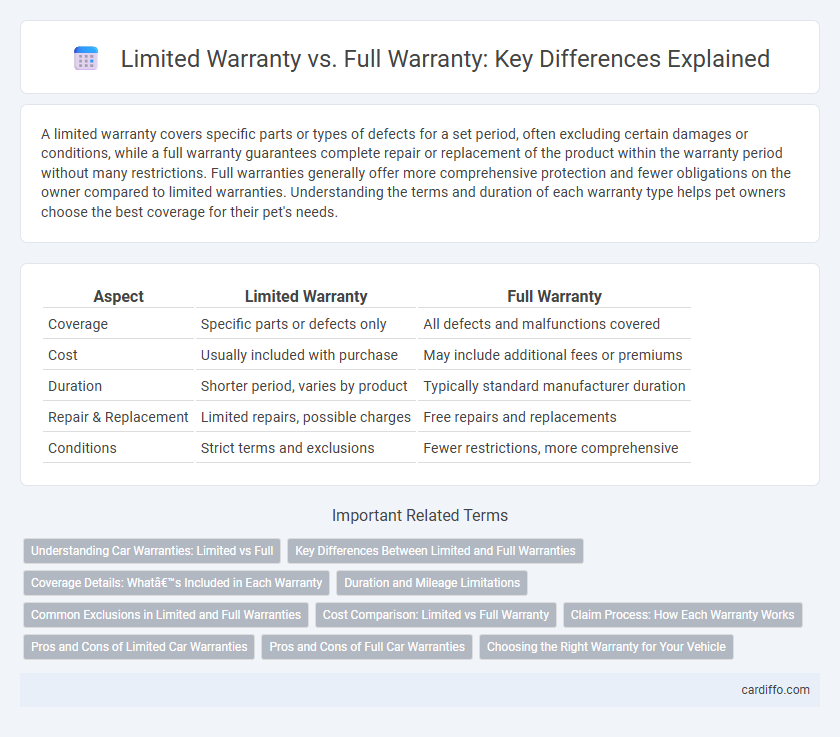A limited warranty covers specific parts or types of defects for a set period, often excluding certain damages or conditions, while a full warranty guarantees complete repair or replacement of the product within the warranty period without many restrictions. Full warranties generally offer more comprehensive protection and fewer obligations on the owner compared to limited warranties. Understanding the terms and duration of each warranty type helps pet owners choose the best coverage for their pet's needs.
Table of Comparison
| Aspect | Limited Warranty | Full Warranty |
|---|---|---|
| Coverage | Specific parts or defects only | All defects and malfunctions covered |
| Cost | Usually included with purchase | May include additional fees or premiums |
| Duration | Shorter period, varies by product | Typically standard manufacturer duration |
| Repair & Replacement | Limited repairs, possible charges | Free repairs and replacements |
| Conditions | Strict terms and exclusions | Fewer restrictions, more comprehensive |
Understanding Car Warranties: Limited vs Full
Limited warranties cover specific parts or types of repairs for a defined period, often excluding wear-and-tear and requiring certain maintenance conditions. Full warranties provide comprehensive coverage for repairs or replacements of any defects in materials or workmanship, without many exclusions, usually with no extra cost to the owner. Understanding these distinctions helps car buyers assess protection levels and potential out-of-pocket expenses during the ownership period.
Key Differences Between Limited and Full Warranties
Limited warranties restrict coverage by specifying certain conditions, exclusions, or time frames for repairs and replacements, often requiring the consumer to bear some costs. Full warranties promise comprehensive coverage without significant limitations, offering free repairs, replacements, or refunds within the warranty period if the product fails. Key differences include the extent of coverage, consumer cost responsibility, and the obligations of the manufacturer to fix or replace defective products.
Coverage Details: What’s Included in Each Warranty
Limited warranty typically covers specific parts and defects for a set period, excluding normal wear and tear or damage caused by misuse. Full warranty offers comprehensive coverage, including repair or replacement of any defective parts, often with no additional costs or restrictions on usage. Both warranties vary by manufacturer, but full warranty generally provides broader protection and fewer limitations for consumers.
Duration and Mileage Limitations
Limited warranties typically specify strict duration and mileage limits, such as 3 years or 36,000 miles, restricting coverage to defects within these parameters. Full warranties often offer broader protection with longer duration or higher mileage limits, like 5 years or 60,000 miles, covering repairs and replacements more comprehensively. Understanding these timeframes and mileage caps is crucial for vehicle owners to maximize warranty benefits and avoid unexpected expenses.
Common Exclusions in Limited and Full Warranties
Limited warranties often exclude coverage for damages caused by user negligence, unauthorized repairs, and normal wear and tear, restricting the scope of protection. Full warranties typically offer more comprehensive coverage but may still exclude damages from accidents, misuse, or alterations to the product. Both warranty types commonly exclude consumable parts, software issues, and damages resulting from environmental factors such as water or extreme temperatures.
Cost Comparison: Limited vs Full Warranty
Limited warranty typically incurs lower upfront costs but may lead to higher out-of-pocket expenses for repairs not covered, while full warranty generally involves higher initial fees with comprehensive coverage minimizing future repair costs. Consumers often weigh the cost-effectiveness by analyzing the frequency and type of potential repairs relative to warranty price differences. Businesses offering full warranties usually factor these costs into product pricing, reflecting the value of extensive protection versus the economical appeal of limited warranty options.
Claim Process: How Each Warranty Works
Limited warranty claims require proof of purchase and often limit coverage to specific parts or defects, with customers typically responsible for shipping or repair costs beyond the warranty scope. Full warranty claims usually cover all defects and repairs without extra charges, offering a simpler process that includes free parts and labor within the warranty period. Claim approvals under full warranties tend to be faster and more straightforward, while limited warranties may involve more documentation and restrictions.
Pros and Cons of Limited Car Warranties
Limited car warranties typically cover specific parts or repairs for a set period or mileage, offering cost savings compared to full warranties. Pros include lower initial costs and targeted coverage for major components, while cons involve potential out-of-pocket expenses for non-covered parts and restricted repair locations. Consumers should evaluate the scope of coverage and exclusions to determine if a limited warranty meets their vehicle protection needs.
Pros and Cons of Full Car Warranties
Full car warranties offer comprehensive coverage, including repairs and replacements for defects and malfunctions, providing peace of mind and potentially saving significant out-of-pocket costs. However, these warranties often come with higher upfront premiums and strict maintenance requirements to avoid voiding coverage. Consumers benefit from predictable expenses but should weigh the balance between cost and the extent of coverage offered.
Choosing the Right Warranty for Your Vehicle
Choosing the right warranty for your vehicle involves understanding the key differences between limited and full warranties. A limited warranty covers specific parts or repairs for a set period, often excluding wear-and-tear items, while a full warranty offers comprehensive coverage with no exclusions, typically including all necessary repairs during the warranty period. Assessing factors such as vehicle age, usage, and budget helps determine whether a limited or full warranty best suits your protection needs and financial plan.
Limited Warranty vs Full Warranty Infographic

 cardiffo.com
cardiffo.com